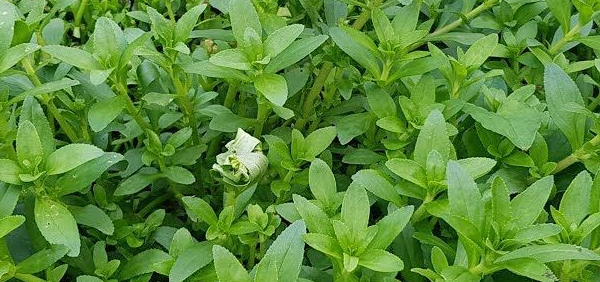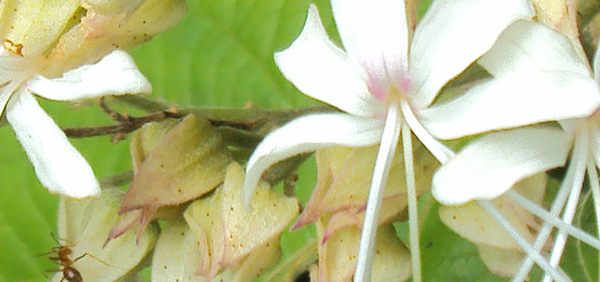bimbi :
 Bimb£ consists of the dried leaves of Coccinia grandis (L.) Voigt Syn. C. cordifolia Cogn, C.indica W &
A, Cephalandra indica Naud. (Fam. Cucurbitaceae), a monoecious perennial climber, distributed all over India and
often cultivated.
Bimb£ consists of the dried leaves of Coccinia grandis (L.) Voigt Syn. C. cordifolia Cogn, C.indica W &
A, Cephalandra indica Naud. (Fam. Cucurbitaceae), a monoecious perennial climber, distributed all over India and
often cultivated.Taxonomical Classification
Family: CucurbitaceaeVERNACULAR NAMES
Sanskrit: bimbi, rakta phala, gola, rundi, dontacchadopama , Tundi, Bimbika, OsthopamaphalaEnglish: Ivy gourd
Hindi: Kunduru, Kunru
Urdu: Kunduru
Telugu: Donda tige
Bengali: Tela Kuccha, Bimbu
Marathi: Tondlee
Oriya: Kainchi kakudi, Bano Kundri
Gujarathi: Gholam, Ghilodi, Tindoran, Kadavi Ghilodi
Tamil: Kovai
Malayalam: Koval, Kova, Nallakova
Kannada: Tonde balli
Punjabi: Kunduru, Kunduri
Synonyms
Synonyms in Ayurveda: bimbi, rakta phala, gola, rundi, dontacchadopama , Tundi, Bimbika, OsthopamaphalaRasa: Kashaya Madhura Tikta
Guna: Laghu
Veerya: Sheetha
Vipaka: Katu
Karma: Kaphapittasamaka
Phytochemistry:
Cephalandrine A, cephalandrine B, cephalandrine, β-sitosterol and triacontane.Dosage:
leaf - Svarasa(Juice) : 10 to 20 ml Curna (Powder) : 3 to 6 gstem - Curna (Powder): 3 to 6 g.
Morphology:
Bulk colour dark green; leaves brittle; simple, alternate, petiolate, exstipulate, 5 to 10 cm. long and 4 to 8 cm in width; lamina variable in size, usually 5 angled with shallow sinuses; bright green above with blackish dots on the surface and paler beneath; palmately reticulate with five main veins, base cordate, apex acute, margin more or less sinuate toothed; surface of the lamina rough.Stems pieces measuring 2 to 10 cm in length and 0.5 to 4 cm in thickness, externally ridged, grey or
greenish grey; cut surface smooth with a thin bark and abundant light coloured central wide wood; odour and taste
indistinct
Histology:
Midrib -TS of midrib is flat toward adaxial surface and ridged towards abaxial side; epidermal cells of adaxial and abaxial surface brick shaped; hypodermis adjacent to both epidermis collenchymatous; ground tissue of parenchyma containing prismatic calcium oxalate crystals; two vascular bundles present, one towards adaxial and the other towards abaxial surface; adaxial vascular bundle smaller than that of abaxial surface; xylem composed of vessels with annular and spiral thickenings, xylem parenchyma, and fibres; phloem contains sieve tubes with simple sieve plates, companion cells, parenchyma and fibres. Lamina -TS through laminar region shows that the leaf is dorsiventral; cuticle present; epidermal cells of adaxial surface slightly elongated, larger and oval where black dots representing glands present; the epidermal cells of abaxial surface are brick shaped; cuticle present; palisade layer a single row; and absent over midrib region; spongy parenchyma cells chlorenchymatous and wavy walled; xylem contains vessels with annular and spiral thickenings;epidermal cells of both adaxial and abaxial epidermis in surface view are occasionally elongated, walls thin, deeply sinuate; multicellular sessile glandular trichomes with head measuring 100 to 120 µ in diameter are present on adaxial epidermis; covering trichomes measuring 18 to 20 wide and 280 to 300 µ long, gradually tapering are sparsely distributed and are localised at the costal region of the adaxial epidermis; stomata anomocytic ; stomatal index of abaxial epidermis 20 to 25, adaxial surface 16 to 18.In TS the mature stem consists of cork, composed of stratified rectangular, tangentially elongated cells;
cortex composed of 10 to 15 layers of thin walled, isodiametric parenchymatous cells with intercellular spaces,
filled with numerous concentric starch grains, of about 5 µ in diameter; pericycle in the form of patches of fibres,
with thick walls, narrow lumen, measuring 10 to 15 µ in diameter; vascular bundles conjoint, wedge shaped,
bicollateral, phloem contains sieve tubes, companion cells, extensive parenchyma of isodiametric cells, and fibres
of 550 to 625 µ long and 12 to 18 µ width , xylem consists of vessels with reticulate and scalariform thickenings,
protoxylem elements possess annular and spiral thickenings; very short fibres upto 30 µ in width, walls very
thick with simple pits; medullary rays multiseriate, composed of 18 to 22 radially elongated with some filled
with starch grains; pith scanty, parenchymatous, cells isodiametric, thin walled.
Therapeutic Uses:
leaf - Kāmalā (Jaundice), Madhumeha (Diabetes mellitus), Puya meha (Dysuria)stem - Aruci (Tastelessness), Prameha (Metabolic disorder), Prav¢hik¢
(Dysentery), Raktapitta (Bleeding disorder)
IMPORTANT FORMULATIONS – Bimbighritam, Bimbi Guna, Bimbi Phala Guna , Bimbi Saka, Bimbi Puspam, Bimbi Phalam, Tundi Ghrt, Kunadaru
guna, Tiktatundi Guna, Bimbi (Pancanga), Bimbiphalam
- » Classification and names of bimbi
- » Synonyms and definitions of bimbi
- » Drug Properties of bimbi
- » Chemical Constituents of bimbi
- » Standardization of bimbi
- » Parts used and Dosage of bimbi
- » Morphology and Histology of bimbi
- » Distribution and Conservation of bimbi
- » Cultivation of bimbi
- » bimbi in the market
- » Medicinal Uses of bimbi
- » Researches and clinical trails of bimbi
- » bimbi in other sytems of medicine
- » Ayurvedic formulations with bimbi
- » Images of bimbi













